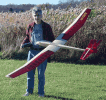|
A link budget commonly refers to the complete gain and loss equation from the
transmitter, through the ambient medium (air, cable, waveguide, fiber, etc.) and
through to the receiver. Although the complete equation would incorporate many terms,
the high-level block diagram shown below is often used.
See the 1-Way Path Loss and
2-Way Path Loss calculators.
Prx = Ptx + Gtx + Grx - Afs
- Am
| where: |
Prx = received power at detector ( dBW )
|
|
Ptx = transmitter output power ( dBW ) |
|
Gtx = transmitter antenna gain ( dBi ) |
|
Grx = receiver antenna gain ( dBi ) |
|
Afs = free space attenuation ( dB ) |
|
Am = miscellaneous attenuation ( radome, rain, etc. ) |

Posted September 12, 2023
|









